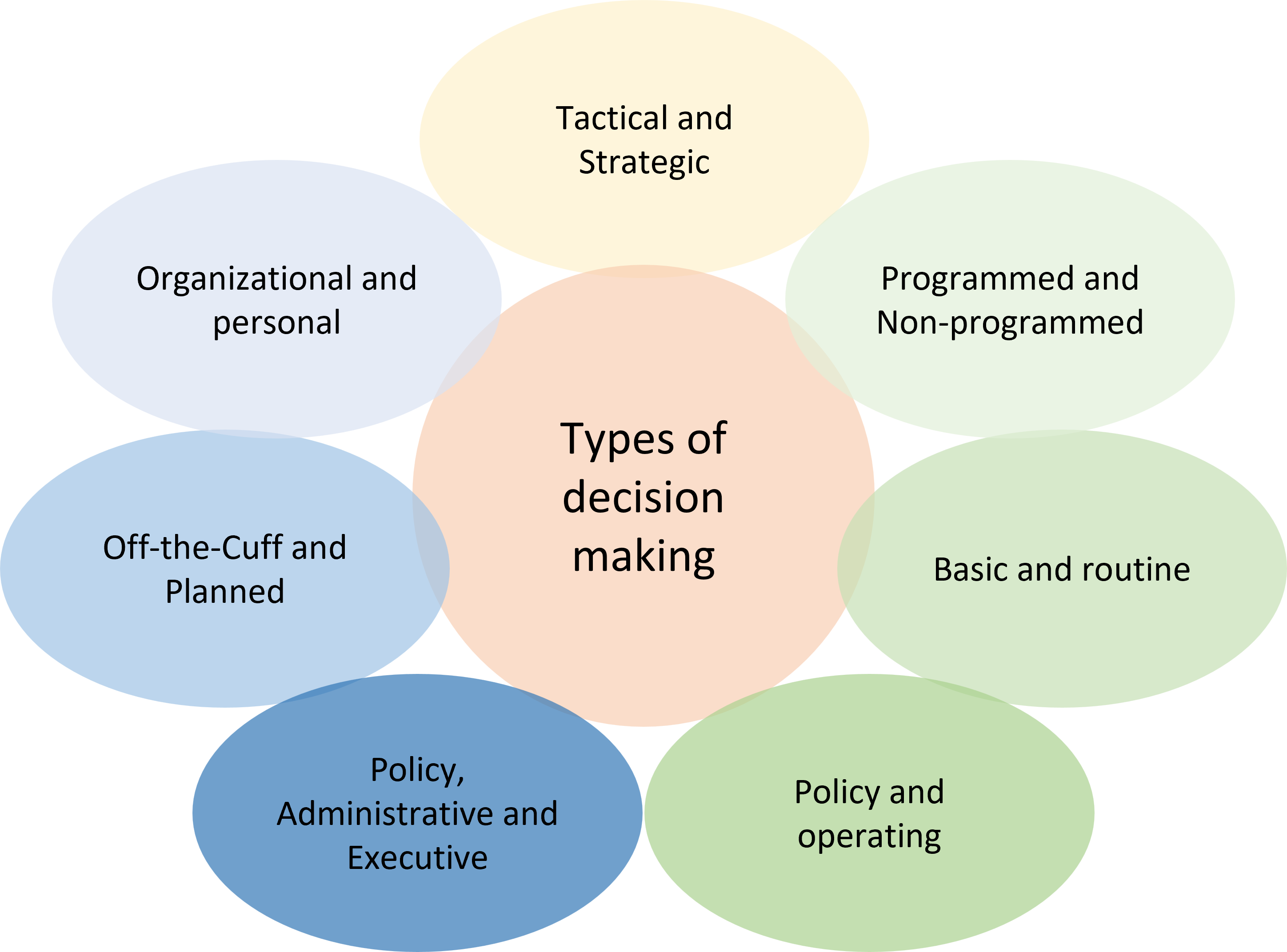.png)
Classification and Effective method
Basic classifications of decision that one makes in a day:
Programmed vs. Non-Programmed Decisions: Programmed decisions are routine decisions that are made regularly and follow a standard procedure or set of rules. Non-programmed decisions, on the other hand, are made in response to unique or novel situations that require a more flexible approach.
Strategic vs. Operational Decisions: Strategic decisions are long-term decisions that affect the overall direction of the organization, such as mergers and acquisitions or entry into new markets. Operational decisions, on the other hand, are shorter-term decisions that focus on day-to-day activities, such as hiring and firing employees or managing inventory.
Individual vs. Group Decisions: Individual decisions are made by a single person, whereas group decisions are made by a group of people. Group decisions can be more effective in some cases because they allow for diverse perspectives and knowledge.

Rational vs. Intuitive Decisions: Rational decisions are made by using a systematic and logical approach, whereas intuitive decisions rely on gut instincts and personal experiences. Both approaches have their strengths and weaknesses, and the most effective decision-making often involves a combination of both.
Consensus vs. Authority Decisions: Consensus decisions are made by reaching a mutual agreement among a group of individuals, while authority decisions are made by a single person or group of people with decision-making power. Consensus decisions can lead to more buy-in and commitment from stakeholders, but they can also be time-consuming and difficult to reach.
Good decision and bad decision making:
Good decision making involves a rational and systematic process that leads to an outcome that aligns with the decision maker's goals and objectives. Good decisions are informed by evidence, data, and other relevant information, and involve weighing the pros and cons of different options before selecting the best course of action. Good decision making involves considering the perspectives and needs of stakeholders and considering the potential risks and benefits of different options.
On the other hand, bad decision making is characterized by a lack of careful consideration, insufficient or biased information, and a failure to weigh the pros and cons of different options. Bad decisions may be made hastily, without adequate analysis or input from stakeholders. They may also be influenced by personal biases or other external factors, rather than objective criteria.

The key difference between good and bad decision making is the process by which decisions are made. Good decision making involves a systematic and rational approach, while bad decision making is often characterized by impulsiveness or a lack of careful consideration. Good decisions are typically based on evidence and analysis, while bad decisions may be based on incomplete or biased information. Ultimately, good decision-making leads to outcomes that are aligned with the decision maker's goals and objectives, while bad decisions may lead to unintended consequences or negative outcomes.
Right decision vs decision right:
The difference between making the right decision and deciding right lies in the process and outcome of the decision-making. Making the right decision means selecting the option that aligns with your objectives, goals, and values, and leads to the desired outcome. It involves analysing the situation, gathering information, evaluating alternatives, and choosing the option that has the highest probability of success.
On the other hand, deciding right focuses on the decision-making process rather than the outcome. It involves making a decision based on the right principles, values, and ethics, regardless of the outcome. Deciding right means making decisions that are morally and ethically sound, and that align with your values and beliefs.
For example, let's say a company is faced with the decision to lay off employees due to financial constraints. Making the right decision would mean choosing the option that minimizes the impact on employees and the company's reputation while addressing the financial issue. However, deciding right would involve considering the well-being and dignity of the employees and making the decision in a fair and ethical manner, even if it means choosing a less favourable option for the company.
In summary, making the right decision focuses on the outcome and selecting the best option, while deciding right focuses on the decision-making process and ensuring that the decision aligns with one's values and ethics. Both are important in decision-making and can lead to positive outcomes when done effectively.
Guidelines for effective decision making:
Effective decision making requires a systematic approach that involves understanding the problem, setting objectives, identifying alternatives, assessing risks, gathering evidence, considering stakeholders, managing time, and acknowledging personal values. Let's look at an example of how these guidelines can be applied in real life
Mark is the manager of a small manufacturing company. He has received a request from a potential customer to provide a large order of products at a very short notice. He needs to decide whether to accept the order or not. Mark follows the guidelines for effective decision making as follows
Need Analysis: Mark analyses the situation and understands the problem that requires a decision. He clarifies that the problem is to determine whether to accept the large order or not.
Objectives: Mark sets the objective to maximize profits while maintaining the quality of the products.
Alternatives: Mark identifies three alternatives - accept the order, partially accept the order, or decline the order.
Risks: Mark assesses the risks associated with each alternative. He identifies that accepting the order may require him to invest in additional resources and may cause delays in fulfilling other orders. Partially accepting the order may result in a loss of revenue. Declining the order may risk losing the potential customer in the future.
Evidence: Mark gathers evidence by analysing the financial feasibility of each alternative and the capacity of his production line to fulfil the order.
Stakeholders: Mark considers the needs and perspectives of his employees, suppliers, customers, and the potential customer. He identifies that accepting the order may require overtime for employees and may impact the delivery schedule of other orders. He also communicates with the potential customer to understand their expectations.
Time: Mark considers the urgency of the situation and the availability of resources before deciding.
Personal Values:Mark acknowledges his personal values of maintaining a good relationship with customers and providing quality products.
After following these guidelines, Mark decides to partially accept the order, as it maximizes his profits while maintaining the quality of the products. He communicates his decision to the potential customer and provides a realistic timeline for delivery.
This example demonstrates how effective decision making involves a systematic approach that considers various factors and alternatives before arriving at a decision.